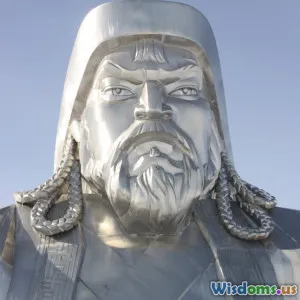
How to Separate Fact From Myth in the Life of Genghis Khan
8 min read Explore how to distinguish fact from fiction in Genghis Khan's life and legacy. (0 Reviews)
How to Separate Fact From Myth in the Life of Genghis Khan
Genghis Khan is one of history's most compelling figures, simultaneously admired and vilified. His name conjures images of ruthless conquests, vast empires, and a man who reshaped the medieval world. But how much of what we ‘know’ about Genghis Khan is rooted in fact, and how much in myth? Understanding this difference is essential to truly appreciate the man and his impact. This article dives deep into separating legend from reality, revealing the true complexity behind the Mongol leader’s life.
The Power and Problems of Historical Mythmaking
When raw history meets popular storytelling, the result is often a distortion—stories shaped by time, politics, and culture. Myths can amplify the character of a historical figure, simplifying narratives for easier consumption. But myths also obscure facts and can perpetuate stereotypes or falsehoods.
Genghis Khan’s life suffers particularly from this phenomenon. Written mostly by chroniclers from cultures conquered by the Mongols or from oral traditions transmitted through centuries, these stories are inevitably colored by bias and mythic embellishment.
Example: The Notorious “Mass Murderer” Stamp
Many early sources paint Genghis Khan as an unrelenting massacrer who destroyed entire cities, slaughtering millions indiscriminately. While undeniably a fierce military leader responsible for brutal campaigns, more recent scholarship points out that these accounts often exaggerate casualty figures and ignore Mongol strategies of incorporating local leaders and allowing religious freedom. For example, the destruction of Khwarazm was devastating, but Mongol rule thereafter allowed commerce and cultural exchange to flourish in parts of Central Asia.
Sources for Separating Myth From Fact
Understanding Genghis Khan requires triangulating various sources, each with its strengths and limitations:
1. The "Secret History of the Mongols"
This 13th-century Mongol text is the closest primary source on Genghis Khan’s life and offers valuable insight from an insider perspective. Written shortly after his death, it combines biography with legendary storytelling. While more historically grounded than many sources, its tone at times ventures into propaganda, aiming to legitimize his lineage and reign.
2. Persian and Arabic Histories
Works such as Juvaini’s "History of the World Conqueror" and Rashid al-Din’s chronicle provide detailed but sometimes hostile views of Mongol rule, emphasizing the devastation Mongols brought to Islamic states. These sources tend to exaggerate violence and destruction but are critical for understanding the wider geopolitical consequences.
3. Archaeological and Genetic Research
Recent advancements have brought archaeological digs at Mongol sites and modern genetic studies, such as those tracing Genghis Khan’s Y-chromosome lineage across Asia. They provide hard data underpinning the scale of Mongol expansions and challenge myths like the “Black Death” being solely carried by the Mongols.
4. Comparative Cultural Studies
Mongol oral traditions, folklore from conquered peoples, and modern Mongolian historians help reconstruct a more balanced narrative and reveal the internal governance, law, and culture that Genghis Khan fostered.
Common Myths Debunked
Myth 1: Genghis Khan Was Nothing But a Ruthless Brutalizer
Fact: Genghis Khan was indeed a formidable military commander with a ruthless streak, but he also implemented groundbreaking laws, promoted meritocratic leadership, and supported trade and communication across Eurasia. He established the Yassa, a legal code that unified the Mongol tribes.
Myth 2: Genghis Khan Destroyed All Culture and Learning
Fact: Although his armies destroyed regions, Genghis Khan’s empire became a catalyst for the famous Pax Mongolica, facilitating trade along the Silk Road and promoting intellectual exchange across continents. He protected religious leaders and allowed diverse faiths freedom to practice.
Myth 3: The Casualty Numbers Are Exaggerated Without Basis
Fact: Some kill counts attributed to the Mongols are wildly inflated, often to demonize them. Modern historical demography uses archaeological data and contemporary records to find more realistic estimates, though it's clear many campaigns resulted in significant loss of life.
Why It Matters to Get It Right
Separating fact from myth about Genghis Khan is not merely academic but shapes how we understand global history and cross-cultural relations. Misconceptions can perpetuate negative stereotypes toward Mongolian heritage and mask the complexities of medieval geopolitics.
In modern Mongolia, Genghis Khan symbolizes unity and national pride, prompting a reassessment of his legacy away from purely Western or Islamic-centric narratives.
Furthermore, learning how to critically evaluate sources, understanding bias, and recognizing the fluid nature of historical memory is vital in a world awash with information — echoing lessons relevant beyond history.
Conclusion: Embracing Complexity Over Simplification
Genghis Khan was neither a pure villain nor an unblemished hero. He was a product of his turbulent times—a visionary leader who united the Mongol tribes, reshaped the world politically and culturally, but also caused great suffering. By combining multi-perspective historical analysis, we can dispel misconceptions and appreciate the layered truth.
In doing so, we're reminded that history isn't just about facts or legends. It's about discovering the interplay between them, applying critical thought, and gaining a richer understanding of humanity's past.
So next time you hear a sweeping statement about Genghis Khan, remember to ask: is this fact, myth, or a fascinating mix of both?
“The greatest happiness is to scatter your enemy, to drive him before you, to see his camp, to take his wife and daughters.” – Attributed to Genghis Khan, reflecting the realities and brutalities of his era, contrasting the more pragmatic and strategic sides unearthed through modern study.
Recommended Reading:
- "Genghis Khan and the Making of the Modern World" by Jack Weatherford
- "The Secret History of the Mongols" (translation by Francis Woodman Cleaves)
- "The Mongols" by David Morgan
These works provide excellent starting points for those eager to dive deeper into separating fact from myth.
Rate the Post
User Reviews
Popular Posts
















